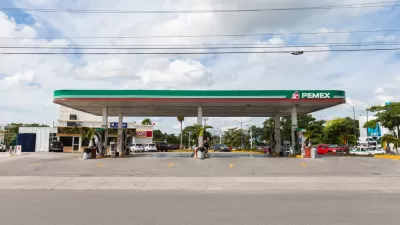Mexico is poised to allow foreign investment in its state-owned oil company, Pemex, for the first time in 75 years. In Venezuela, home to the world's cheapest gasoline, prices are due to skyrocket if President Maduro ends subsidies as he's indicated.
Mexico and Venezuela are the West's two major oil producers whose oil companies are state-owned, or "owned by the people", as their supporters describe it. Both are experiencing declining production. Change, though of different types, appears to be coming to both nations that may increase oil production and boost federal revenues.
As we posted here in August, Mexico, 'the world's ninth largest oil producer and first to nationalize its oil production, has seen steep production declines as the state-owned oil company lacks (the necessary) capital resources and expertise" to invest in oil production. With "legislation passed by Congress on 13 December and ratified by a majority of Mexican states" and signed by President Enrique Pena Nieto on Dec. 20, the tide may be reversed, as the BBC News indicates.
"This is the beginning of a new history for our country. We have opened the doors for a better future for all," said Mr Pena Nieto.
The historic legislation amends the constitution to "allow foreign investment in oil, gas and electricity," i.e. the energy market has been opened. Christian A. DeHaemer, in his piece in Energy & Capital, "Mexico Oil: Full Gusher" predicts that "(f)racking, the same technology that is quickly turning the United States into the world's biggest producer of oil and natural gas, will soon transform Mexico as well."
However, one last potential hurdle to the influx of foreign capital may be a referendum submitted by the Party of the Democratic Revolution, or PRD, that opposes the change which they characterize as privatization, writes Juan Montez of the Wall Street Journal.
And in Venezuela, the world's thirteenth largest oil producer, President Nicolas Maduro indicates he will reduce, if not eliminate, the government's substantial subsidy of oil prices that keeps gasoline prices at a nickel a gallon, though it's obtained on the black market for a penny a gallon, write the staff of The Truth About Cars (TTAC). We posted here in March that under Maduro's predecessor, Hugo Chávez, "[e]nergy experts say his gasoline subsidies doubled domestic consumption, cutting deeply into exports in addition to "draining the budget of $1.5 billion annually."
While the article's title suggests gas prices could rise to $1.60 gallon, they write that "it’s unknown how much Maduro will raise the price." In an AP article, "Venezuela car owners unfazed by planned fuel hike", the reporters suggest that as long as the amount of the increase isn't publicized, the people are not worrying.
Gas prices in Venezuela have been unchanged for 20 years, as has been the federal gas tax in the U.S. While subsidizing gas prices is different than subsidizing transportation expenditures because of insufficient gas tax revenue ($41 billion since 2008, and $14 billion in 2015, as noted here), there are analogies to consider. For example, both subsidies drain federal budgets and keep gas prices artificially low, which increases driving.
FULL STORY: Mexican president signs controversial oil and gas law

Study: Maui’s Plan to Convert Vacation Rentals to Long-Term Housing Could Cause Nearly $1 Billion Economic Loss
The plan would reduce visitor accommodation by 25,% resulting in 1,900 jobs lost.

Alabama: Trump Terminates Settlements for Black Communities Harmed By Raw Sewage
Trump deemed the landmark civil rights agreement “illegal DEI and environmental justice policy.”

Why Should We Subsidize Public Transportation?
Many public transit agencies face financial stress due to rising costs, declining fare revenue, and declining subsidies. Transit advocates must provide a strong business case for increasing public transit funding.

Paris Bike Boom Leads to Steep Drop in Air Pollution
The French city’s air quality has improved dramatically in the past 20 years, coinciding with a growth in cycling.

Why Housing Costs More to Build in California Than in Texas
Hard costs like labor and materials combined with ‘soft’ costs such as permitting make building in the San Francisco Bay Area almost three times as costly as in Texas cities.

San Diego County Sees a Rise in Urban Coyotes
San Diego County experiences a rise in urban coyotes, as sightings become prevalent throughout its urban neighbourhoods and surrounding areas.
Urban Design for Planners 1: Software Tools
This six-course series explores essential urban design concepts using open source software and equips planners with the tools they need to participate fully in the urban design process.
Planning for Universal Design
Learn the tools for implementing Universal Design in planning regulations.
Smith Gee Studio
Alamo Area Metropolitan Planning Organization
City of Santa Clarita
Institute for Housing and Urban Development Studies (IHS)
City of Grandview
Harvard GSD Executive Education
Toledo-Lucas County Plan Commissions
Salt Lake City
NYU Wagner Graduate School of Public Service



























